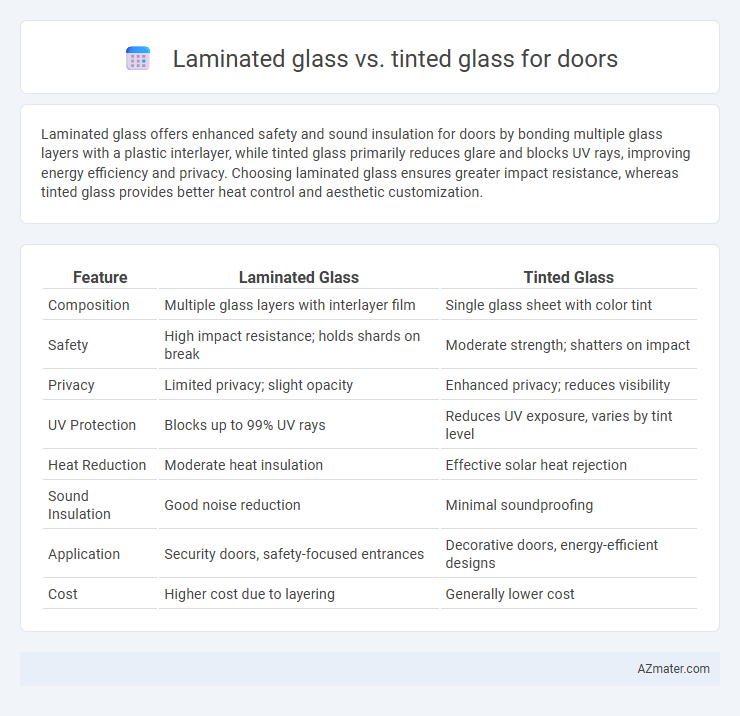Laminated glass offers enhanced safety and sound insulation for doors by bonding multiple glass layers with a plastic interlayer, while tinted glass primarily reduces glare and blocks UV rays, improving energy efficiency and privacy. Choosing laminated glass ensures greater impact resistance, whereas tinted glass provides better heat control and aesthetic customization.
Table of Comparison
| Feature | Laminated Glass | Tinted Glass |
|---|---|---|
| Composition | Multiple glass layers with interlayer film | Single glass sheet with color tint |
| Safety | High impact resistance; holds shards on break | Moderate strength; shatters on impact |
| Privacy | Limited privacy; slight opacity | Enhanced privacy; reduces visibility |
| UV Protection | Blocks up to 99% UV rays | Reduces UV exposure, varies by tint level |
| Heat Reduction | Moderate heat insulation | Effective solar heat rejection |
| Sound Insulation | Good noise reduction | Minimal soundproofing |
| Application | Security doors, safety-focused entrances | Decorative doors, energy-efficient designs |
| Cost | Higher cost due to layering | Generally lower cost |
Introduction to Laminated and Tinted Glass for Doors
Laminated glass for doors consists of two or more layers of glass bonded with a durable interlayer, enhancing safety by preventing shattering upon impact. Tinted glass incorporates color pigments to reduce glare and limit solar heat transmission, improving energy efficiency and privacy. Both laminated and tinted glass options offer unique benefits tailored to door applications, balancing security, aesthetics, and environmental control.
Composition and Structure of Laminated Glass
Laminated glass consists of two or more glass layers bonded together with an interlayer of polyvinyl butyral (PVB) or ethylene-vinyl acetate (EVA), providing enhanced safety and sound insulation compared to tinted glass, which is typically a single pane with a colored film or coating to reduce glare and heat. The sandwich structure of laminated glass ensures that, upon impact, the interlayer holds the shards together, preventing shattering and increasing durability for door applications. In contrast, tinted glass relies primarily on its coloration for UV protection without the added structural resilience found in laminated glass.
Characteristics and Benefits of Tinted Glass
Tinted glass for doors offers enhanced privacy by reducing transparency and limiting visibility from the outside while allowing natural light to pass through. It effectively reduces glare and minimizes heat buildup by blocking a significant portion of solar UV rays, contributing to energy efficiency and increased comfort. Additionally, tinted glass helps protect interior furnishings from fading due to UV exposure and adds an aesthetic appeal with its sleek, modern look.
Safety and Security: Laminated vs Tinted Glass
Laminated glass offers superior safety and security for doors by holding shards in place upon impact, reducing the risk of injury and deterring forced entry. Tinted glass primarily reduces glare and heat but does not provide significant resistance to breakage or intrusion. Choosing laminated glass enhances protection against accidents and break-ins, making it the preferred option for secure door installations.
Energy Efficiency and UV Protection Comparison
Laminated glass offers superior UV protection by blocking up to 99% of harmful ultraviolet rays, reducing interior fading and enhancing occupant comfort. Tinted glass improves energy efficiency by reducing solar heat gain, which lowers cooling costs, but its UV protection is generally less effective than laminated glass. Choosing laminated glass for doors prioritizes maximum UV defense and safety, while tinted glass emphasizes energy savings through heat reduction.
Acoustic Insulation Differences
Laminated glass offers superior acoustic insulation for doors due to its interlayer that effectively dampens sound vibrations, reducing noise transmission significantly. Tinted glass primarily focuses on controlling solar heat and glare, providing minimal impact on soundproofing capabilities. Choosing laminated glass enhances privacy and comfort by creating a quieter indoor environment compared to tinted glass.
Aesthetic Impact on Door Design
Laminated glass enhances door design by offering a sleek, clear appearance that maximizes natural light while providing safety and sound insulation. Tinted glass creates a sophisticated, modern look by reducing glare and adding privacy with various color options that complement architectural styles. Both options significantly influence aesthetics, with laminated glass favoring transparency and brightness, while tinted glass emphasizes mood and ambiance.
Maintenance and Durability Factors
Laminated glass offers superior durability and enhanced safety due to its multi-layer construction, which resists shattering and reduces maintenance from potential cracks or breaks. Tinted glass provides UV protection and reduces glare, but its color coating may fade over time, requiring more frequent upkeep to maintain its appearance. For door applications, laminated glass generally demands less maintenance and provides longer-lasting structural integrity compared to tinted glass.
Cost Considerations: Laminated vs Tinted Glass
Laminated glass for doors typically costs more than tinted glass due to its complex manufacturing process involving multiple glass layers bonded with an interlayer for enhanced safety and sound insulation. Tinted glass tends to be more affordable as it primarily involves adding color or film to standard glass, reducing solar heat gain while offering basic privacy. Choosing laminated glass provides greater durability and security but increases upfront expenses, whereas tinted glass offers cost-effective energy savings with limited impact on safety.
Choosing the Right Glass for Your Door Needs
Laminated glass offers enhanced security and sound insulation for doors, making it ideal for safety-focused environments, while tinted glass provides UV protection and privacy by reducing glare and heat transmission. Choosing the right glass depends on your specific needs: laminated glass is suited for increased impact resistance and durability, whereas tinted glass is preferred for energy efficiency and aesthetic appeal. Consider factors like safety requirements, energy savings, and desired transparency when selecting door glass solutions.

Infographic: Laminated glass vs Tinted glass for Door
 azmater.com
azmater.com